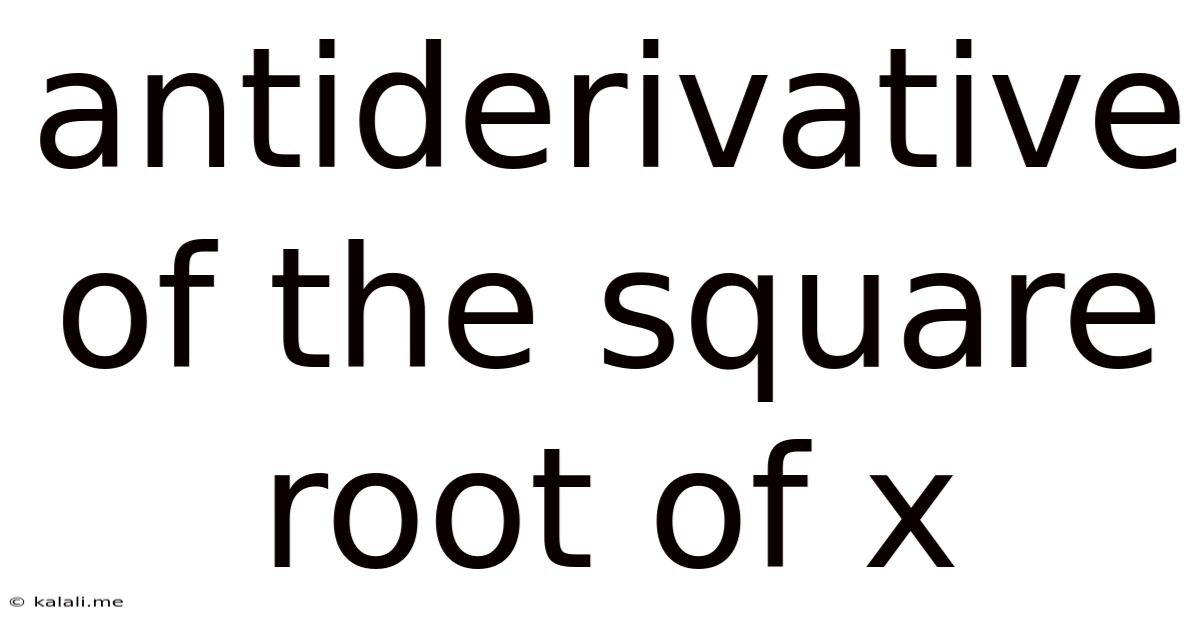Antiderivative Of The Square Root Of X
Kalali
Apr 04, 2025 · 5 min read

Table of Contents
Finding the Antiderivative of the Square Root of x: A Comprehensive Guide
The seemingly simple function √x, or x<sup>1/2</sup>, presents a surprisingly rich landscape when exploring its antiderivative. This article delves deep into the process of finding the antiderivative, exploring various approaches, clarifying common misconceptions, and extending the concept to related problems. We'll also touch upon the practical applications of this fundamental concept in calculus.
Understanding the Concept of Antiderivatives
Before diving into the specifics of √x, let's solidify our understanding of antiderivatives. An antiderivative, also known as an indefinite integral, is the inverse operation of differentiation. If the derivative of a function F(x) is f(x), then F(x) is an antiderivative of f(x). Crucially, the antiderivative is not unique; adding a constant (C) to any antiderivative yields another valid antiderivative. This constant represents the family of curves sharing the same derivative.
The Power Rule in Reverse:
The cornerstone of finding many antiderivatives is the power rule of differentiation, which states:
d/dx (x<sup>n</sup>) = nx<sup>n-1</sup>
To find the antiderivative, we reverse this process. We increase the exponent by 1 and divide by the new exponent. This leads to the power rule for integration:
∫x<sup>n</sup> dx = (x<sup>n+1</sup>)/(n+1) + C (where n ≠ -1)
The exception, n = -1, leads to the natural logarithm.
Calculating the Antiderivative of √x
Now, let's apply this knowledge to our function, √x, which can be written as x<sup>1/2</sup>. Using the power rule for integration:
∫x<sup>1/2</sup> dx = (x<sup>(1/2)+1</sup>)/((1/2)+1) + C
Simplifying:
∫x<sup>1/2</sup> dx = (x<sup>3/2</sup>)/(3/2) + C
Further simplification gives us:
∫√x dx = (2/3)x<sup>3/2</sup> + C
This is the antiderivative of √x. The constant C is crucial; it represents the infinite number of possible antiderivatives, each differing only by a vertical shift.
Visualizing the Antiderivative
It's helpful to visualize what this means. The function √x is a curve starting at the origin and increasing at a decreasing rate. Its antiderivative, (2/3)x<sup>3/2</sup> + C, represents a family of curves. Each curve in this family has the property that its slope at any point x is equal to √x. Changing the value of C simply shifts the entire curve vertically without altering its slope at any point.
Extending the Concept: Definite Integrals and Area Calculation
While the indefinite integral gives a family of antiderivatives, the definite integral provides a specific numerical value. The definite integral of a function from a to b represents the signed area under the curve between those limits.
For √x, the definite integral from a to b is:
∫<sub>a</sub><sup>b</sup> √x dx = [(2/3)x<sup>3/2</sup>]<sub>a</sub><sup>b</sup> = (2/3)b<sup>3/2</sup> - (2/3)a<sup>3/2</sup>
This calculation allows us to find the area under the curve of √x between any two points a and b. For example, the area under the curve from 0 to 4 is:
∫<sub>0</sub><sup>4</sup> √x dx = (2/3)(4)<sup>3/2</sup> - (2/3)(0)<sup>3/2</sup> = (2/3)(8) = 16/3
Applications of the Antiderivative of √x
The antiderivative of √x finds application in various fields:
- Physics: Calculating displacement from a given velocity function, where the velocity is proportional to the square root of time.
- Engineering: Determining the volume of solids of revolution generated by rotating the square root function around an axis.
- Economics: Modeling certain economic processes involving growth or decay functions with a square root component.
- Probability and Statistics: Calculating probabilities associated with probability density functions that involve the square root function.
Common Mistakes and Misconceptions
Several common mistakes can occur when calculating the antiderivative of √x or similar functions:
- Forgetting the constant of integration (C): This is a crucial step; omitting C leads to an incomplete and inaccurate answer.
- Incorrect application of the power rule: Mistakes in exponent manipulation are common. Double-check your calculations carefully.
- Confusing differentiation and integration: Remember that integration is the reverse of differentiation; the rules are opposites.
- Incorrect simplification: Be meticulous in simplifying your answer to obtain the simplest form.
Advanced Applications and Extensions
The concepts discussed above can be extended to more complex scenarios:
- Antiderivatives of functions involving √x: Consider functions like ∫x<sup>2</sup>√x dx or ∫(√x + 1)<sup>2</sup> dx. These can be solved by applying algebraic manipulation and the power rule.
- Antiderivatives with variable limits of integration: Exploring how the value of the definite integral changes as the limits of integration vary.
- Numerical Integration techniques: For integrals that are difficult or impossible to solve analytically, numerical methods like Simpson's rule or the trapezoidal rule can be employed.
Conclusion
Finding the antiderivative of √x is a fundamental exercise in calculus that demonstrates the power and elegance of integral calculus. By understanding the power rule, the concept of the constant of integration, and applying these principles to related problems, one can confidently tackle more complex integration challenges. The applications of this seemingly simple calculation extend far beyond theoretical mathematics, providing essential tools for solving problems across numerous disciplines. Remember to practice diligently, master the fundamental rules, and always double-check your work for accuracy. This will solidify your understanding and empower you to solve even more challenging integration problems in the future.
Latest Posts
Latest Posts
-
How Many Ml In 2 Litres
Apr 10, 2025
-
How Many Pints In Half A Gallon
Apr 10, 2025
-
Is 16 A Prime Number Or A Composite Number
Apr 10, 2025
-
How Many Feet In 132 Inches
Apr 10, 2025
-
How Many Centimeters Is 16 Inches
Apr 10, 2025
Related Post
Thank you for visiting our website which covers about Antiderivative Of The Square Root Of X . We hope the information provided has been useful to you. Feel free to contact us if you have any questions or need further assistance. See you next time and don't miss to bookmark.